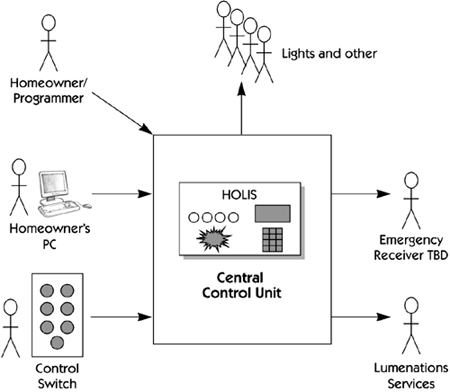The Case Study: The HOLIS Use Cases
| Let's see how we can apply use cases in our case study. In Chapter 7, the HOLIS team applied systems engineering as a problem analysis technique to better understand the systems architecture and design constraints for HOLIS, our state-of-the-art home lighting automation system. During that process the team produced the context diagram for the system (Figure 14-7). Figure 14-7. HOLIS context diagram Figure 14-4. Storyboard slide for step 2 of a use case Figure 14-5. Storyboard slide for step 3 of a use case Find the HOLIS ActorsIn building the use-case model for the system, the team first revisited the actors, those external users and devices that exist outside the system and interact with the system under development. The process resulted in the discovery of some new actors for the system. Table 14-1 shows the updated list of HOLIS actors (with new names given to a few of the actors identified earlier). Find the HOLIS Use CasesThe team then held a brainstorming session to identify the primary HOLIS use cases and wrote a brief description for each one. Among others, they identified a simple use case they called "Turn Light On/Off" and described it as follows . Table 14-1. Revised List of HOLIS System Actors
Associate the Actors and Use CasesAfter identifying each of the primary use cases for the system, the team built a visual use-case model to illustrate the relationships between the actors and the various use cases with which the actors interact. Figure 14-8 shows a portion of that model. Figure 14-8. A portion of the HOLIS use-case model Outline the Use CasesOver the course of development, the team proceeded to outline and then further elaborate each of the use cases identified in the use-case model by building a name , description, and initial flow of the events outlined for each use case. That's the appropriate level of detail for the HOLIS project at this time. We'll revisit the "Turn Light On/Off" use case again later in Chapter 21, Refining the Use Cases. |
EAN: N/A
Pages: 257
- Chapter VIII Personalization Systems and Their Deployment as Web Site Interface Design Decisions
- Chapter IX Extrinsic Plus Intrinsic Human Factors Influencing the Web Usage
- Chapter X Converting Browsers to Buyers: Key Considerations in Designing Business-to-Consumer Web Sites
- Chapter XIV Product Catalog and Shopping Cart Effective Design
- Chapter XVI Turning Web Surfers into Loyal Customers: Cognitive Lock-In Through Interface Design and Web Site Usability




